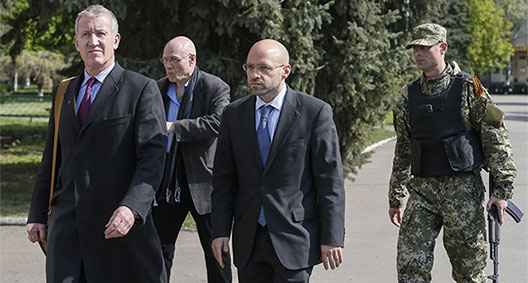
Militia’s Detention of Monitoring Team Underscores Challenges to Group Tasked as Neutral Observer
The Organization for Security and Cooperation in Europe (OSCE) has deployed about 150 of what are to be at least 300 monitors in Ukraine in its mission to de-escalate its conflict with Russian-backed separatists in the country’s south and east. Patience, restraint and calm are the weapons of choice for these monitors. And a background in the military or law enforcement comes in quite handy. These are especially critical for those monitors navigating the volatile region of far southeastern Ukraine, where secessionist militias have declared their independence as the Donetsk People’s Republic.
|
No sooner had the OSCE mission’s six-month mandate begun on March 22, when it had to help arrange the release of hostages, said the Ukraine mission’s press spokesman, Michael Bociurkiw.
An OSCE military verification team – invited by the government in Kyiv and led by German officers – was on a military observation mission separate from that of the civilian monitors. The military team was taken into custody by the Donetsk People’s Republic militants, and the OSCE civilians were tasked with facilitating their release.
Mark Etherington, a veteran of mediation work in conflict zones, led the talks for the release of the team’s twelve people, among them three Ukrainian security service officers. This required daily, two-hour drives from the city of Donetsk to Slaviansk, through multiple roadblocks and checkpoints manned by disparate groups who do not communicate with each other, Bociurkiw said in a telephone interview from Kyiv. After six days of talks with the militants, the detainees were released.
The military expertise of many of the monitors comes in handy in identifying weaponry they are seeing in use in the militant-held areas. Among these are rocket-propelled grenades and “man-portable” anti-aircraft missile systems, particularly around Slaviansk. “This is very alarming. This is not equipment that you find in a hardware store or a police station,” he said.
Navigating the conflict zone is no easy task. Explaining the purpose of the OSCE is sometimes as much of a challenge as getting through a roadblock manned by a nervous young man brandishing an AK47. “Our monitors have to spend quite a bit of time explaining to people what the OSCE is and what it is we are doing here – what the Geneva agreement is. People simply don’t know” said Bociurkiw.
Monitors have printed up Russian and Ukrainian translations of the OSCE mandate, along with information about the terms of the Geneva agreement which puts their special monitoring mission in the role of trying to facilitate the de-escalation of the conflict. While the monitors work a 24/7 schedule, traveling in teams of four, sometimes in armored vehicles, the reality on the ground forces changes to their plans in unpredictable and often dangerous ways. In eastern Ukraine, teams are based in Kharkiv and Donetsk. From these cities, they drive out to different towns to monitor events and interview local officials, NGOs – and a lot of just-plain-angry citizens. The most violent conflict zone, from the cities of Slaviansk and Kramatorsk south to the provincial capital of Donetsk, is often a “no-go” area, Bociurkiw said.
Recently a team en route from Donetsk to Luhansk was held up for many hours in Yanakievo, the hometown of ousted president Viktor Yanukovych, Bociurkiw said. The head of the OSCE mission had to intervene and persuade the armed militants not to keep the team captive.
Monitors find that generally people are willing to talk to them. One of the most common complaints is that Ukraine’s central authorities have not paid attention to their problems and needs, Bociurkiw said. The mayor of Donetsk talks about decentralization, while residents focus on the lack of employment opportunities.
Whatever their position or issue of choice, people are happy to be heard, says Bociurkiw. And that seems to calm everyone down.
Irena Chalupa covers Ukraine and Eastern Europe for the Atlantic Council.
Image: Mark Etherington (L), the deputy head of the Ukraine mission from the Organization for Security and Cooperation in Europe (OSCE), arrives with teammates at the mayor's office in Slaviansk April 27, 2014. Etherington sought the release of an OSCE military observer team taken captive by separatist gunmen commanded by Igor Strelkov, a man Ukraine says is an undercover Russian army officer. (Reuters/Gleb Garanich)

